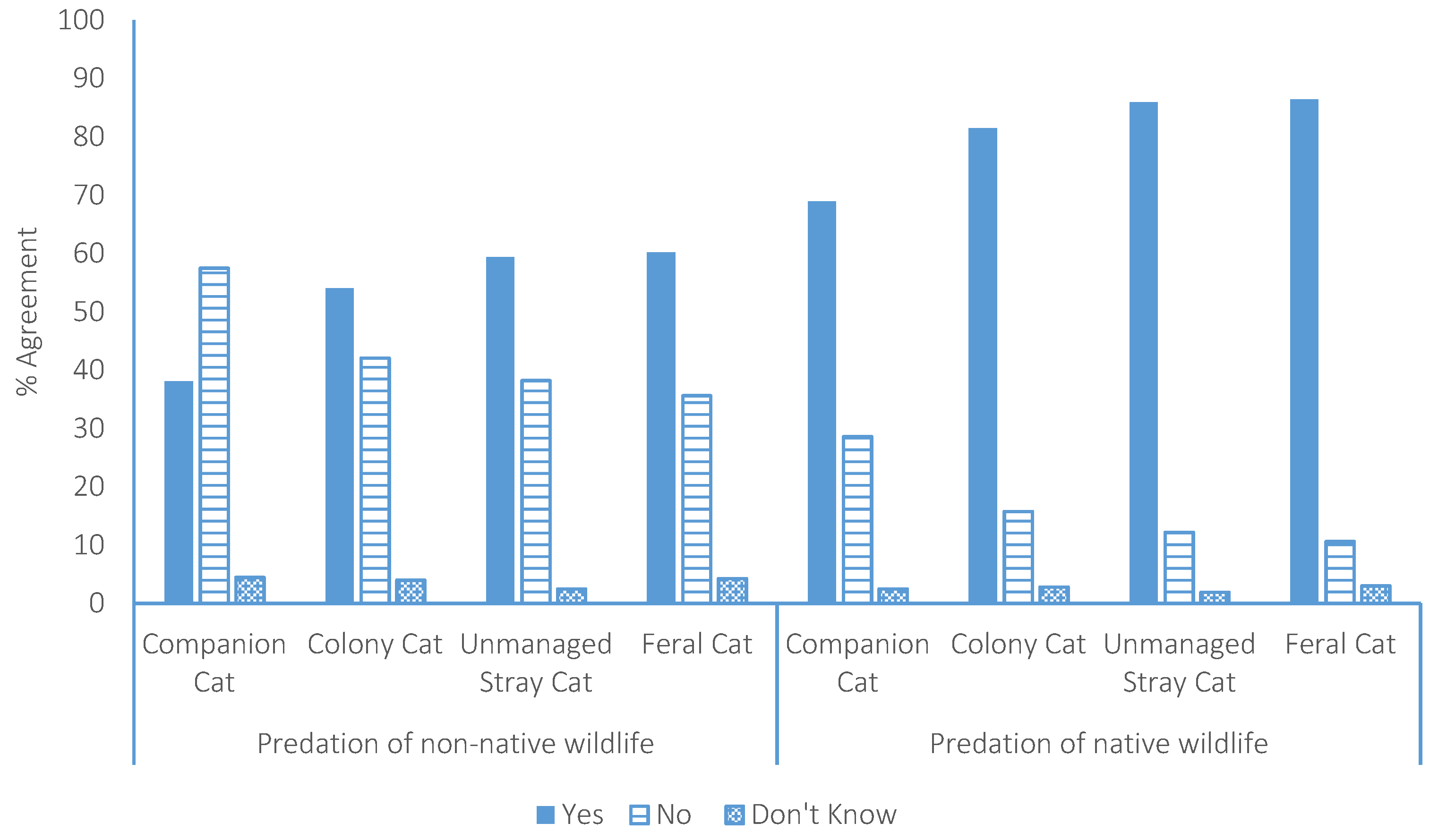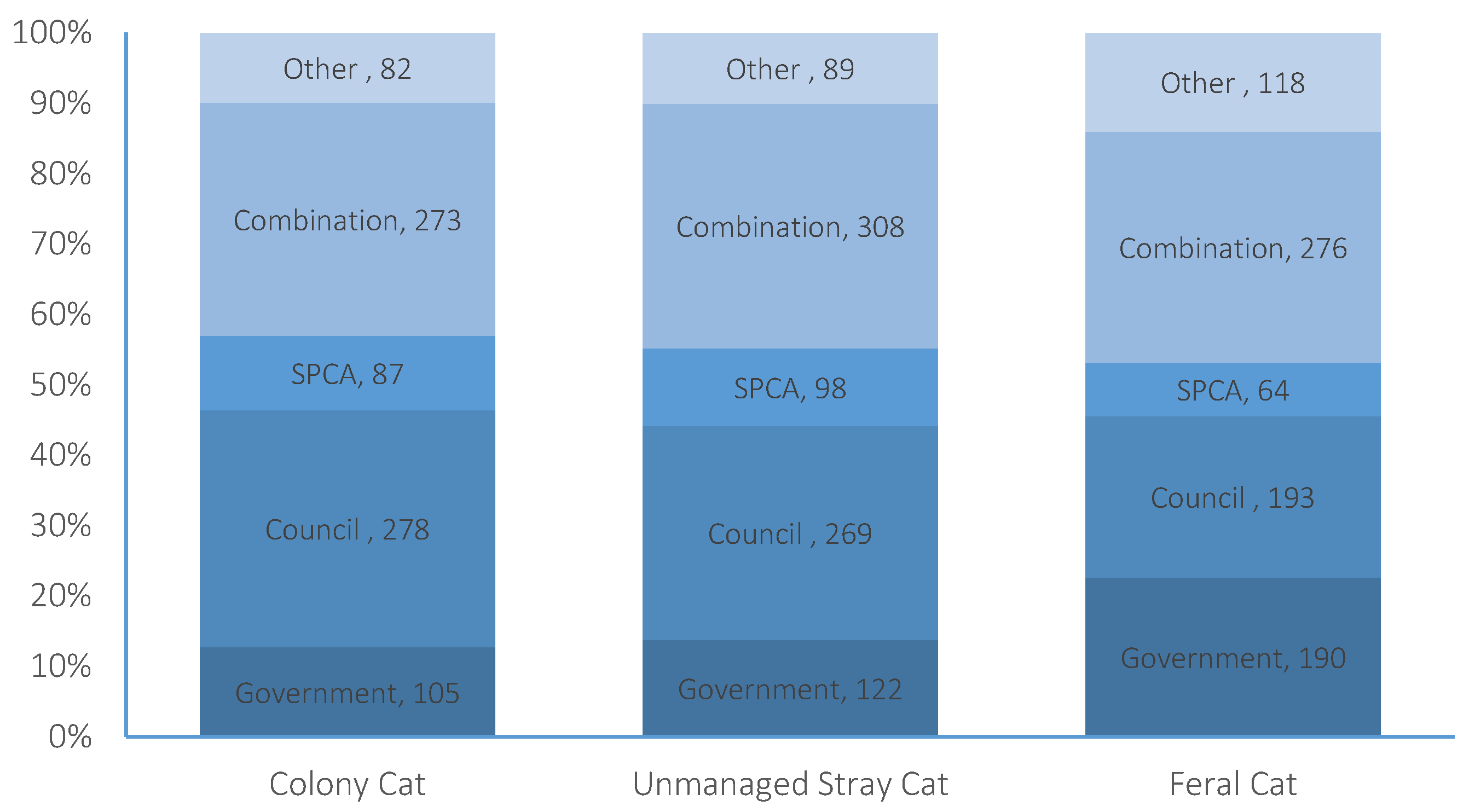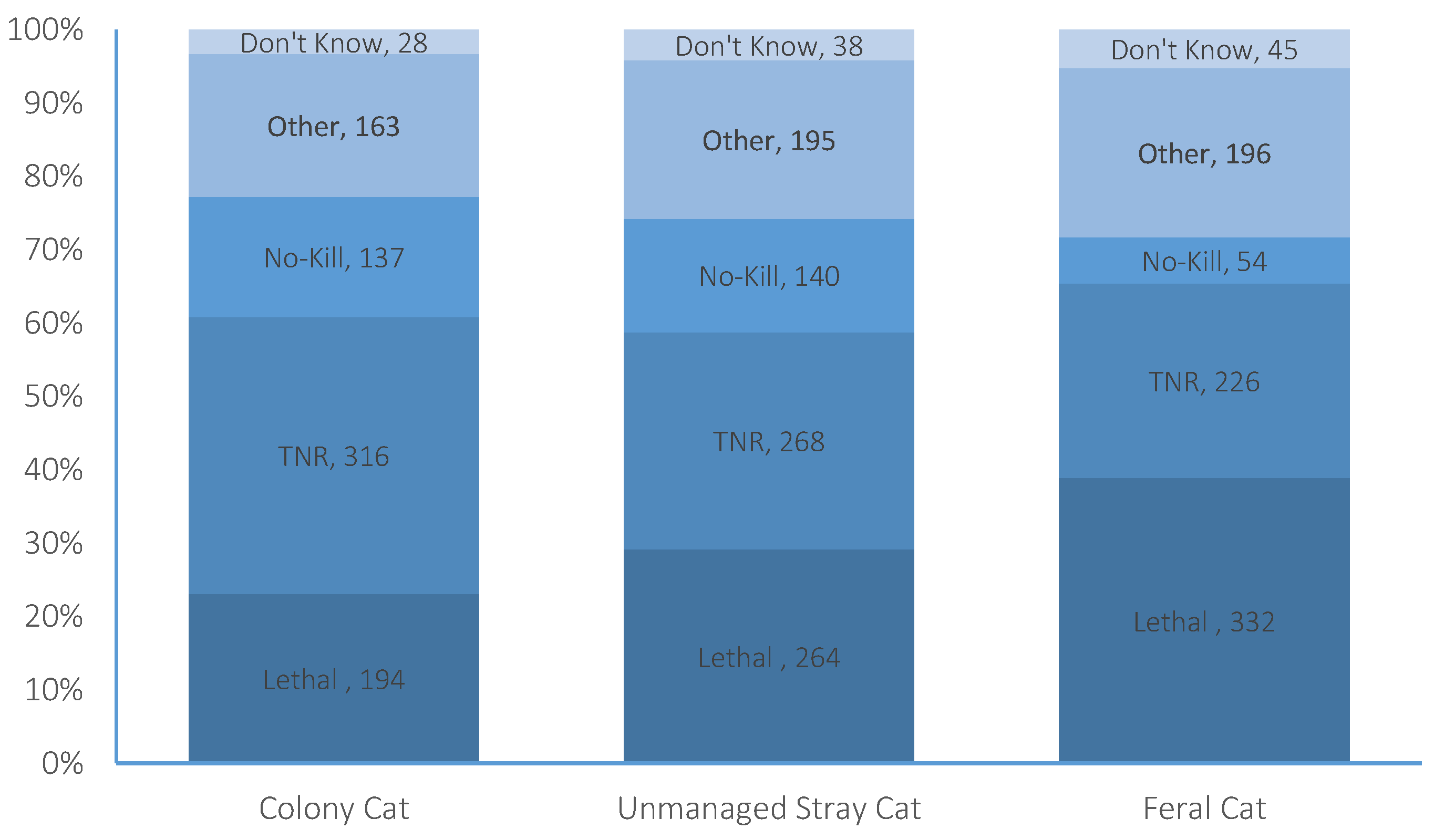A Survey of Public Opinion on Cat (Felis catus) Predation and the Future Direction of Cat Management in New Zealand
Abstract
:Simple Summary
Abstract
1. Introduction
- Companion cats: domestic cats that live with humans and are dependent on humans for their welfare [14].
- Stray cats: companion cats that are lost or abandoned and are living as an individual or in a group. Stray cats live around centres of human habitation and have their needs provided by for, either directly or indirectly, by humans.
- Feral cats: not stray or owned and have none of their needs provided for by humans. Feral cats generally do not live around centres of human habitation [14].
- A range of management measures thought to contribute to the reduction of risk to wildlife, and;
- Demographic variables that influence these opinions.
2. Materials and Methods
2.1. Participants
2.2. Questionnaire Design
“A companion cat (1) is a common domestic cat that lives with humans and is dependent on humans for its welfare” [14].
“A stray cat is a companion cat that is lost or abandoned and that is living as an individual or in a group. Stray cats live around centres of human habitation. There are two categories of stray cat, colony and unmanaged. Colony cats (2) have many of their needs, such as food and shelter, directly supplied by humans. Unmanaged stray cats (3) have their needs supplied indirectly by humans by scavenging etc.”
“A feral cat (4) is a cat that is not stray or owned and that has none of its needs provided for by humans. Feral cats generally do not live around centres of human habitation” [14].
“Lethal methods can be employed to kill cats and reduce population numbers. These methods may include poisoning and kill trapping”.
“Trap-Neuter-Return is a program through which stray and feral cats are trapped humanely; de-sexed and medically treated; and then returned to the location where they were found”.
“Nothing—leave the cat populations as they are”.
2.3. Statistical Analysis
3. Results
3.1. A National Cat Management Strategy
3.2. Cat Predation
3.3. Management of Companion Cats
3.4. Management of Colony Cats
3.5. Management of Unmanaged Stray Cats
3.6. Management of Feral Cats
4. Discussion
4.1. Cat Predation
4.2. Management of Companion Cats
4.3. Management of Unowned Cats
4.4. Limitations
5. Conclusions
Supplementary Materials
Acknowledgments
Author Contributions
Conflicts of Interest
References
- New Zealand Companion Animal Council Inc. Companion Animals in New Zealand; New Zealand Companion Animal Council Inc.: Auckland, New Zealand, 2016. [Google Scholar]
- van Heezik, Y.; Smyth, A.; Adams, A.; Gordon, J. Do domestic cats impose an unsustainable harvest on urban bird populations? Biol. Conserv. 2010, 143, 121–130. [Google Scholar] [CrossRef]
- Bernstein, P.L. The human-cat relationship. In The Welfare of Cats; Springer: Berlin, Germany, 2007; pp. 47–89. [Google Scholar]
- Friedmann, E.; Son, H. The human-companion animal bond: How humans benefit. Vet. Clin. N. Am. Small. 2009, 39, 293–326. [Google Scholar] [CrossRef] [PubMed]
- Serpell, J. Beneficial effects of pet ownership on some aspects of human health and behaviour. J. R. Soc. Med. 1991, 84, 717–720. [Google Scholar] [PubMed]
- Wells, D.L. The effects of animals on human health and well-being. J. Soc. Issues 2009, 65, 523–543. [Google Scholar] [CrossRef]
- Gillies, C.; Clout, M. The prey of domestic cats (Felis catus) in two suburbs of Auckland city, New Zealand. J. Zool. 2003, 259, 309–315. [Google Scholar] [CrossRef]
- Loyd, K.A.T.; Hernandez, S.M.; Carroll, J.P.; Abernathy, K.J.; Marshall, G.J. Quantifying free-roaming domestic cat predation using animal-borne video cameras. Biol. Conserv. 2013, 160, 183–189. [Google Scholar] [CrossRef]
- Dabritz, H.; Conrad, P.A. Cats and toxoplasma: Implications for public health. Biol. Conserv. 2010, 57, 34–52. [Google Scholar]
- Nutter, F.B.; Levine, J.F.; Stoskopf, M.K. Reproductive capacity of free-roaming domestic cats and kitten survival rate. J. Am. Vet. Med. Assoc. 2004, 225, 1399–1402. [Google Scholar] [CrossRef] [PubMed]
- Perry, G. Cats-perceptions and misconceptions: Two recent studies about cats and how people see them. In Proceedings of the Eight National Conference on Urban Animal Management in Australia, Gold Coast, Brisbane, Australia, 12–13 August 1999; pp. 127–130. [Google Scholar]
- Toukhsati, S.R.; Young, E.; Bennett, P.C.; Coleman, G.J. Wandering cats: Attitudes and behaviors towards cat containment in Australia. Anthrozoös 2012, 25, 61–74. [Google Scholar] [CrossRef]
- Loyd, K.; Hernandez, S.; Abernathy, K.; Shock, B.; Marshall, G. Risk behaviours exhibited by free roaming cats in a suburban US town. Vet. Rec. 2013, 173, 295. [Google Scholar] [CrossRef] [PubMed]
- National Animal Welfare Advisory Committee. Animal Welfare (Companion Cats) Code of Welfare; Ministry of Primary Industries: Wellington, New Zealand, 2007. [Google Scholar]
- Mahlow, J.C.; Slater, M.R. Current issues in the control of stray and feral cats. J. Am. Vet. Med. Assoc. 1996, 209, 2016–2020. [Google Scholar] [PubMed]
- Farnworth, M.J.; Muellner, P.; Benschop, J. A Systematic Review of the Impacts of Feral, Stray and Companion Domestic Cats (Felis Catus) on Wildlife in New Zealand and Options for Their Management; New Zealand Veterinary Association: Wellington, New Zealand, 2013. [Google Scholar]
- Baker, P.; Bentley, A.J.; Ansell, R.J.; Harris, S. Impact of predation by domestic cats (Felis catus) in an urban area. Mamm. Rev. 2005, 35, 302–312. [Google Scholar] [CrossRef]
- Lepczyk, C.A.; Mertig, A.G.; Liu, J. Landowners and cat predation across rural-to-urban landscapes. Biol. Conserv. 2004, 115, 191–201. [Google Scholar] [CrossRef]
- Courchamp, F.; Langlais, M.; Sugihara, G. Cats protecting birds: Modelling the mesopredator release effect. J. Anim. Ecol. 1999, 68, 282–292. [Google Scholar] [CrossRef]
- Norbury, G.; Heyward, R. Predictors of clutch predation of a globally significant avifauna in New Zealand’s braided river ecosystems. Anim. Conserv. 2008, 11, 17–25. [Google Scholar] [CrossRef]
- Woods, M.; McDonald, R.A.; Harris, S. Predation of wildlife by domestic cats (Felis catus) in Great Britain. Mamm. Rev. 2003, 33, 174–188. [Google Scholar] [CrossRef]
- Dowding, J.E.; Murphy, E.C. The impact of predation by introduced mammals on endemic shorebirds in New Zealand: A conservation perspective. Biol. Conserv. 2001, 99, 47–64. [Google Scholar] [CrossRef]
- Aguilar, G.D.; Farnworth, M.J. Stray cats in Auckland, New Zealand: Discovering geographic information for exploratory spatial analysis. Appl. Geogr. 2012, 34, 230–238. [Google Scholar] [CrossRef]
- Metsers, E.M.; Seddon, P.J.; van Heezik, Y.M. Cat-exclusion zones in rural and urban-fringe landscapes: How large would they have to be? Wildl. Res. 2010, 37, 47–56. [Google Scholar] [CrossRef]
- Lilith, M.; Calver, M.; Styles, I.; Garkaklis, M. Protecting wildlife from predation by owned domestic cats: Application of a precautionary approach to the acceptability of proposed cat regulations. Austral Ecol. 2006, 31, 176–189. [Google Scholar] [CrossRef]
- Gordon, J.; Matthaei, C.; Van Heezik, Y. Belled collars reduce catch of domestic cats in New Zealand by half. Wildl. Res. 2010, 37, 372–378. [Google Scholar] [CrossRef]
- Lord, L.K.; Griffin, B.; Slater, M.R.; Levy, J.K. Evaluation of collars and microchips for visual and permanent identification of pet cats. J. Am. Vet. Med. Assoc. 2010, 237, 387–394. [Google Scholar] [CrossRef] [PubMed]
- Lord, L.K.; Wittum, T.E.; Ferketich, A.K.; Funk, J.A.; Rajala-Schultz, P.J. Search and identification methods that owners use to find a lost cat. J. Am. Vet. Med. Assoc. 2007, 230, 217–220. [Google Scholar] [CrossRef] [PubMed]
- Aguilar, G.D.; Farnworth, M.J. Distribution characteristics of unmanaged cat colonies over a 20 year period in Auckland, New Zealand. Appl. Geogr. 2013, 37, 160–167. [Google Scholar] [CrossRef]
- Jones, C. Microchipping and its importance in dogs. Companion Anim. 2013, 18, 468–473. [Google Scholar] [CrossRef]
- Levy, J.; Isaza, N.; Scott, K. Effect of high-impact targeted trap-neuter-return and adoption of community cats on cat intake to a shelter. Vet. J. 2014, 201, 269–274. [Google Scholar] [CrossRef] [PubMed]
- Spotte, S. Foraging. In Free-Ranging Cats; John Wiley & Sons Ltd.: Hoboken, NJ, USA, 2014; pp. 181–213. [Google Scholar]
- Farnworth, M.; Campbell, J.; Adams, N. Public awareness in New Zealand of animal welfare legislation relating to cats. N. Z. Vet. J. 2010, 58, 213–217. [Google Scholar] [CrossRef] [PubMed]
- Wald, D.M.; Jacobson, S.K.; Levy, J.K. Outdoor cats: Identifying differences between stakeholder beliefs, perceived impacts, risk and management. Biol. Conserv. 2013, 167, 414–424. [Google Scholar] [CrossRef]
- Hall, C.M.; Adams, N.A.; Bradley, J.S.; Bryant, K.A.; Davis, A.A.; Dickman, C.R.; Fujita, T.; Kobayashi, S.; Lepczyk, C.A.; McBride, E.A. Community attitudes and practices of urban residents regarding predation by pet cats on wildlife: An international comparison. PLoS ONE 2016, 11, e0151962. [Google Scholar] [CrossRef] [PubMed]
- De Vaus, D.A. Surveys in Social Research; Allen and Unwim: Sydney, Australia, 2002. [Google Scholar]
- Statistics New Zealand. The New Zealand Census of Population and Dwellings. Available online: http://www.stats.govt.nz/Census/2013-census/data-tables/total-by-topic.aspx (accessed on 21 November 2016).
- McGrath, N.; Walker, J.; Nilsson, D.; Phillips, C. Public attitudes towards grief in animals. Anim. Welf. 2013, 22, 33–47. [Google Scholar] [CrossRef]
- Grayson, J.; Calver, M.; Styles, I. Attitudes of suburban Western Australians to proposed cat control legislation. Aust. Vet. J. 2002, 80, 536–543. [Google Scholar] [CrossRef] [PubMed]
- Biben, M. Predation and predatory play behaviour of domestic cats. Anim. Behav. 1979, 27, 81–94. [Google Scholar] [CrossRef]
- Holzapfel, S.; Robertson, H.A.; McLennan, J.A.; Sporle, W.; Hackwell, K.; Impey, M. Kiwi (Apteryx Spp.) Recovery Plan: 2008–2018; Department of Conservation: Wellington, New Zealand, 2008.
- Fountain, J.; Espiner, S.; Xie, X. A cultural framing of nature: Chinese tourists’ motivations for, expectations of, and satisfaction with, their New Zealand tourist experience. Tour. Rev. Int. 2010, 14, 71–83. [Google Scholar] [CrossRef]
- Hall, C.M. Tourism destination branding and its effects on national branding strategies: Brand New Zealand, clean and green but is it smart? Eur. J. Tour. Hosp. Recreat. 2010, 1, 68–98. [Google Scholar]
- Statistics New Zealand. Tourism Satellite Account: 2015. Available online: http://www.stats.govt.nz/browse_for_stats/industry_sectors/Tourism/tourism-satellite-account-2015/Summary_results.aspx (accessed on 21 November 2016).
- Kellert, S.R.; Berry, J.K. Attitudes, knowledge, and behaviors toward wildlife as affected by gender. Wildl. Soc. B 1987, 15, 363–371. [Google Scholar]
- Pifer, L.; Shimizu, K.; Pifer, R. Public attitudes toward animal research: Some international comparisons. Soc. Anim. 1994, 2, 95–113. [Google Scholar] [CrossRef] [PubMed]
- Mathews, S.; Herzog, H.A. Personality and attitudes toward the treatment of animals. Soc. Anim. 1997, 5, 169–175. [Google Scholar] [CrossRef]
- Bjerke, T.; Ødegårdstuen, T.S.; Kaltenborn, B.P. Attitudes toward animals among Norwegian adolescents. Anthrozoös 1998, 11, 79–86. [Google Scholar] [CrossRef]
- Phillips, C.; Izmirli, S.; Aldavood, J.; Alonso, M.; Choe, B.; Hanlon, A.; Handziska, A.; Illmann, G.; Keeling, L.; Kennedy, M. An international comparison of female and male students’ attitudes to the use of animals. Animals 2010, 1, 7–26. [Google Scholar] [CrossRef] [PubMed]
- Walker, J.K.; McGrath, N.; Nilsson, D.L.; Waran, N.K.; Phillips, C.J. The role of gender in public perception of whether animals can experience grief and other emotions. Anthrozoös 2014, 27, 251–266. [Google Scholar] [CrossRef]
- Herzog, H.A., Jr.; Betchart, N.S.; Pittman, R.B. Gender, sex role orientation, and attitudes toward animals. Anthrozoös 1991, 4, 184–191. [Google Scholar] [CrossRef]
- Eldridge, J.J.; Gluck, J.P. Gender differences in attitudes toward animal research. Ethics Behav. 1996, 6, 239–256. [Google Scholar] [CrossRef] [PubMed]
- Serpell, J.A. Factors influencing human attitudes to animals and their welfare. Anim. Welf. 2004, 13, 145–151. [Google Scholar]
- Gunaseelan, S.; Coleman, G.J.; Toukhsati, S.R. Attitudes toward responsible pet ownership behaviors in Singaporean cat owners. Anthrozoös 2013, 26, 199–211. [Google Scholar] [CrossRef]
- Harrod, M.; Keown, A.; Farnworth, M. Use and perception of collars for companion cats in New Zealand. N. Z. Vet. J. 2016, 64, 121–124. [Google Scholar] [CrossRef] [PubMed]
- Jay, M. The political economy of a productivist agriculture: New Zealand dairy discourses. Food Policy 2007, 32, 266–279. [Google Scholar] [CrossRef]
- Bonnington, C.; Gaston, K.J.; Evans, K.L. Fearing the feline: Domestic cats reduce avian fecundity through trait-mediated indirect effects that increase nest predation by other species. J. Appl. Ecol. 2013, 50, 15–24. [Google Scholar] [CrossRef]
- Farnworth, M.J.; Campbell, J.; Adams, N.J. What’s in a name? Perceptions of stray and feral cat welfare and control in Aotearoa, New Zealand. J. Appl. Anim. Welf. Sci. 2011, 14, 59–74. [Google Scholar] [CrossRef] [PubMed]
- Dabritz, H.A.; Atwill, E.R.; Gardner, I.A.; Miller, M.A.; Conrad, P.A. Outdoor fecal deposition by free-roaming cats and attitudes of cat owners and nonowners toward stray pets, wildlife, and water pollution. J. Am. Vet. Med. Assoc. 2006, 229, 74–81. [Google Scholar] [CrossRef] [PubMed]
- Lord, L.K. Attitudes toward and perceptions of free-roaming cats among individuals living in Ohio. J. Am. Vet. Med. Assoc. 2008, 232, 1159–1167. [Google Scholar] [CrossRef] [PubMed]
- Loyd, K.A.T.; Hernandez, S.M. Public perceptions of domestic cats and preferences for feral cat management in the Southeastern United States. Anthrozoös 2012, 25, 337–351. [Google Scholar] [CrossRef]
- Slater, M.R. The welfare of feral cats. In The Welfare of Cats; Springer: Berlin, Germany, 2007; pp. 141–175. [Google Scholar]
- Levy, J.K.; Gale, D.W.; Gale, L.A. Evaluation of the effect of a long-term trap-neuter-return and adoption program on a free-roaming cat population. J. Am. Vet. Med. Assoc. 2003, 222, 42–46. [Google Scholar] [CrossRef] [PubMed]
- Stoskopf, M.K.; Nutter, F.B. Analyzing approaches to feral cat management—One size does not fit all. J. Am. Vet. Med. Assoc. 2004, 225, 1361–1964. [Google Scholar] [CrossRef] [PubMed]
- Foley, P.; Foley, J.E.; Levy, J.K.; Paik, T. Analysis of the impact of trap-neuter-return programs on populations of feral cats. J. Am. Vet. Med. Assoc. 2005, 227, 1775–1781. [Google Scholar] [CrossRef] [PubMed]
- Andersen, M.C.; Martin, B.J.; Roemer, G.W. Use of matrix population models to estimate the efficacy of euthanasia versus trap-neuter-return for management of free-roaming cats. J. Am. Vet. Med. Assoc. 2004, 225, 1871–1876. [Google Scholar] [CrossRef] [PubMed]
- Natoli, E.; Maragliano, L.; Cariola, G.; Faini, A.; Bonanni, R.; Cafazzo, S.; Fantini, C. Management of feral domestic cats in the urban environment of Rome (Italy). Prev. Vet. Med. 2006, 77, 180–185. [Google Scholar] [CrossRef] [PubMed]





| Demographic | Demographic Categories | N | Survey Sample % | New Zealand Census 2013% |
|---|---|---|---|---|
| Age | 18−25 years | 253 | 25% | 14% |
| 26−35 year | 217 | 21% | 16% | |
| 36−45 years | 132 | 13% | 18% | |
| 46−55 years | 134 | 13% | 19% | |
| 56−65 years | 135 | 13% | 15% | |
| 65+ years | 138 | 14% | 18% | |
| Gender | Male | 497 | 49% | 49% |
| Female | 494 | 49% | 51% | |
| Ethnicity | New Zealand European | 515 | 51% | 64% |
| Māori | 70 | 7% | 15% | |
| Asian/Indian | 124 | 12% | 12% | |
| European | 188 | 19% | 8% | |
| Pacific Cook Island | 25 | 2% | 7% | |
| Other | 79 | 8% | 2% | |
| Marital Status | Single | 457 | 45% | 35% |
| Married | 327 | 32% | 48% | |
| Divorced | 52 | 5% | 11% | |
| De facto | 140 | 14% | - | |
| Widowed | 33 | 3% | 6% | |
| Residential Location | Urban | 332 | 32% | 72% # |
| Suburban | 427 | 42% | - | |
| Rural | 145 | 14% | 14% # | |
| Income | <$50,000 per annum | 277 | 27% | 6% |
| $50,000–$100,000 per annum | 262 | 26% | 21% | |
| >$100,000 | 117 | 12% | 6% | |
| No answer | 52 | 5% | 10% | |
| Education | No formal education/Primary | 19 | 2% | 21% |
| Secondary | 224 | 22% | 33% | |
| Certificate/Diploma | 230 | 23% | 29% | |
| Undergraduate | 296 | 29% | 14% | |
| Postgraduate | 229 | 23% | 6% | |
| Employed | Yes | 708 | 70% | 61% |
| No | 301 | 30% | 39% | |
| Cat Owner * | Yes | 326 | 32% | 44% |
| No | 684 | 68% | 56% |
© 2017 by the authors. Licensee MDPI, Basel, Switzerland. This article is an open access article distributed under the terms and conditions of the Creative Commons Attribution (CC BY) license (http://creativecommons.org/licenses/by/4.0/).
Share and Cite
Walker, J.K.; Bruce, S.J.; Dale, A.R. A Survey of Public Opinion on Cat (Felis catus) Predation and the Future Direction of Cat Management in New Zealand. Animals 2017, 7, 49. https://doi.org/10.3390/ani7070049
Walker JK, Bruce SJ, Dale AR. A Survey of Public Opinion on Cat (Felis catus) Predation and the Future Direction of Cat Management in New Zealand. Animals. 2017; 7(7):49. https://doi.org/10.3390/ani7070049
Chicago/Turabian StyleWalker, Jessica K., Stephanie J. Bruce, and Arnja R. Dale. 2017. "A Survey of Public Opinion on Cat (Felis catus) Predation and the Future Direction of Cat Management in New Zealand" Animals 7, no. 7: 49. https://doi.org/10.3390/ani7070049
APA StyleWalker, J. K., Bruce, S. J., & Dale, A. R. (2017). A Survey of Public Opinion on Cat (Felis catus) Predation and the Future Direction of Cat Management in New Zealand. Animals, 7(7), 49. https://doi.org/10.3390/ani7070049




